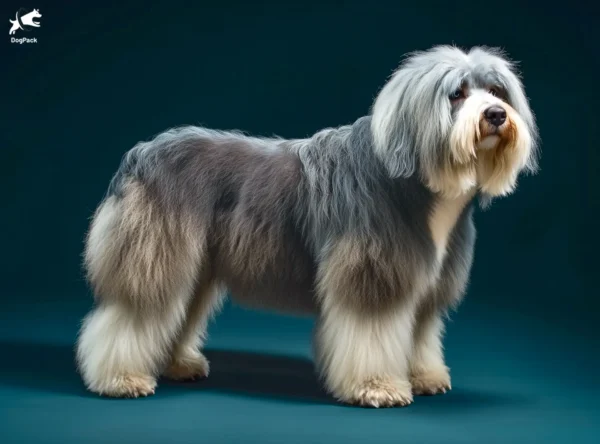Smithfield Dog Breed Info & Overview
With a storied past rooted in herding and droving, the Smithfield Dog remains a hidden gem among rare dog breeds. This rugged worker is celebrated for its keen intelligence, protective nature, and tenacious spirit in the field. At home, it shows a softer side, forging deep bonds with owners who provide ample space, training, and daily challenges.
Characteristics
Pictures
Breed History
The Smithfield Dog traces its origins to England, where it worked as a drover’s companion, particularly around the busy meat markets of Smithfield, London. Valued for their ability to drive cattle and sheep through crowded streets, these shaggy, durable dogs became known for their endurance and working instinct. Their name directly reflects the market they famously served during England’s agricultural past.
During Australia’s colonial era, the Smithfield was introduced by early settlers who needed a versatile and hardy herding dog. The breed adapted quickly to Australian conditions, assisting farmers in managing livestock across challenging terrain. Although it never achieved formal recognition by major kennel clubs, the Smithfield remained a reliable partner for generations of rural Australians, especially in Tasmania, where it is still shown at events like the Campbell Town Show.
Today, the Smithfield survives thanks to older farmers and passionate breeders dedicated to preserving the breed’s original lines. While not officially registered by the Australian National Kennel Council, efforts to maintain the breed continue. Some believe the Smithfield shares ancestry with Old English Sheepdogs, yet it retains distinct qualities—loyalty, endurance, and a rugged, unpolished charm that reflects its working roots.
Temperament, Personality
If you want a dog with boundless enthusiasm for daily challenges, the Smithfield is right up your alley. They’re known for their tenacity in the field and unwavering devotion at home. Confident around the farm, they can be cautious with unfamiliar faces, making early socialization essential. Their alert disposition translates to a natural guarding instinct, beneficial for those needing a protective companion.
Beneath their rugged exterior lies a dog that thrives on close relationships. Smithfields often form deep bonds with family members and enjoy engaging activities that keep their minds busy. They typically do well with older children who respect their space, though supervision is key. Early introductions with other pets usually work out fine, given plenty of positive reinforcement and structure.
Those who have lived with a Smithfield Dog often describe them as hearty comedians. Their keen herding instincts may extend to gently corralling family members, which can be amusing if properly channeled. Patience and consistency help mold a well-rounded Smithfield, transforming them into watchful, affectionate friends ready to join in on any lively adventure.
Physical Characteristics
A mature Smithfield is a sturdy, muscular dog built for endurance. They generally have a broad head, well-developed jaws, and moderately sized ears that may fold over or stand semi-erect. Their eyes carry an inquisitive and intelligent expression, reflecting a calm determination. This breed’s physique enables it to traverse rough terrain or hustle after livestock without missing a beat.
Coat textures can vary, but many Smithfields feature a medium to long, shaggy outer layer that provides weather resistance. Coloring often includes shades of gray, black, or a mix of both, sometimes with white markings on the chest or paws. Their double-coat design helps protect them from harsh conditions but also means diligent grooming is key to maintaining healthy skin and fur.
While they’re classified among larger working dogs, many Smithfields display remarkable agility. A balanced frame and strong hindquarters let them pivot quickly to round up wandering sheep or dash across open fields. The Smithfield Dog’s overall look might appear rustic compared to show-oriented breeds, yet it radiates a purposeful charm that herding enthusiasts find irresistible.
Health Issues
Like many working dogs, Smithfields can be prone to joint problems, especially hip dysplasia. Regular check-ups and screenings from an experienced veterinarian are vital to catch early signs. Providing proper exercise and a balanced diet helps keep their joints lubricated and muscles strong. Because of their size, any limping or stiffness should be addressed promptly to prevent further complications.
Eye conditions, such as progressive retinal atrophy, have been noted in some Smithfield lines. Routine eye exams can detect issues before they affect daily life. Skin irritations might also occur under that dense coat if grooming lapses or parasites go unchecked. Maintaining a consistent health regimen and forging a good rapport with a veterinarian can add years of comfort to your Smithfield Dog’s life.
By proactively managing health, owners can help their Smithfield thrive. Supplements like glucosamine or fish oil, recommended by a vet, may support joint and coat health. Websites like Veterinary Partner offer in-depth articles on orthopedic and ocular diseases. Equally important is a healthy lifestyle—avoiding excessive weight gain and ensuring moderate rest intervals to prevent strain on bones and joints.
Grooming Needs
That thick, weather-resistant coat is both a blessing and a chore. Weekly brushing to remove tangles and shed fur is essential for a Smithfield, as mats can develop quickly in the dense undercoat. A slicker brush or grooming rake works wonders to keep the coat in prime condition. Pay special attention behind the ears and around the legs where knots often sneak in.
Bathing frequency varies by lifestyle. A farm-based Smithfield might need more frequent baths than one living a mostly indoor life. However, be cautious not to over-bathe; stripping the natural oils can dry out the skin. Consider a gentle dog-friendly shampoo and thorough drying to prevent moisture from lingering in the coat, which can lead to skin irritation or mildew-like odors.
Ears and paws also require consistent checks. Debris or moisture trapped in these areas may trigger infections. Trimming the fur between paw pads reduces slipping and keeps the dog comfortable. Regular nail clipping ensures healthy movement, particularly for dogs working on hard terrain. By staying on top of these grooming tasks, a Smithfield Dog’s coat remains both functional and visually appealing.
Exercise Requirements
Smithfields weren’t bred to lounge around all day. They possess high energy levels and thrive on purposeful activities. A simple walk might not cut it—think herding exercises, agility courses, or fetch sessions that keep both mind and body engaged. Owners who enjoy hiking, running, or exploring the outdoors will find a willing partner in this hardworking companion.
To tap into the breed’s natural instincts, offering tasks like rounding up backyard fowl or practicing “find and bring” commands is ideal. Physical stimulation alone isn’t enough; mental puzzles, such as treat-dispensing toys or advanced obedience drills, challenge their intellect. Overlook these needs, and a Smithfield might vent pent-up energy through digging or excessive barking.
Weather rarely deters a dedicated Smithfield Dog. Rain or shine, they’re game for a new adventure. Always consider age and overall health when setting exercise intensity. Younger pups benefit from shorter, controlled play sessions to protect growing joints, while older dogs may appreciate moderate walks with frequent breaks. With consistent engagement, a Smithfield transforms into a content and well-rounded companion.
Training Tips
Herding instincts run deep, so harnessing them from an early age makes training smoother. Start with foundational commands—sit, stay, recall—and gradually introduce herding-based exercises if you have access to a safe environment with livestock or herding trials. Positive reinforcement works wonders for a Smithfield Dog, especially when coupled with clear, consistent communication.
Steadfast and intelligent, they do best when training sessions feel like a game. Incorporate intervals of play or short fetch sessions as rewards. Harsh reprimands can backfire, leading to anxiety or stubbornness. Instead, remain patient and upbeat, acknowledging every small victory. Engaging methods like clicker training tap into their inquisitive nature, transforming lessons into fun challenges.
Socialization is just as vital. Introduce your Smithfield to various sights, sounds, and situations—farm animals, passing cars, neighborhood strolls. Gradually expose them to unfamiliar people and other dogs, rewarding calm behavior. This broadens their comfort zone and reduces reactivity. Over time, you’ll see a more confident, well-adjusted pup that excels both in everyday life and specialized herding roles.
Nutrition, Diet
Because Smithfields are active herders, they need protein-rich meals that support muscle development. Meals containing around 25% to 28% protein from high-quality sources, like lamb or fish, often suit their energetic lifestyle. Carbohydrates from whole grains or vegetables help sustain endurance. Aim for specially formulated kibble or a carefully balanced raw diet that caters to working-breed caloric needs.
On average, an adult Smithfield weighing 60 pounds (27 kg) may require roughly 1,500 to 1,800 calories daily, split into two meals. Dogs with heavier workloads—like daily herding tasks—might need 2,000 calories or more. Keep an eye on body condition: visible ribs suggest increased portions, while a thickening waistline means cutting back. Vet-approved feeding guidelines ensure each dog’s unique needs are met.
Calcium and phosphorus ratios are crucial for skeletal strength, so look for dog foods clearly labeled for large-breed or working dogs. Omega-3 fatty acids from fish oil or flaxseed aid joint flexibility and promote a glossy coat. For Smithfields prone to joint issues, joint-supportive nutrients—such as glucosamine—can be beneficial. Always transition diets gradually to avoid digestive upset and maintain peak performance.
Adoption, Breeders
Finding a Smithfield Dog can be a journey, given its rarity. Reputable breeders often maintain small, dedicated programs focused on preserving working lines. When visiting a breeder, observe the environment, ask about health testing, and meet the parent dogs. Ethical breeders prioritize puppy well-being, ensuring pups are properly socialized and prepared for life as working or companion dogs.
Prospective adopters may also explore herding or farm dog rescues, where Smithfield mixes occasionally turn up. Rehoming an adult dog can be deeply rewarding, especially for owners seeking a companion with some training. Patience, consistency, and understanding are key to helping a rescue adjust. Always verify a rescue dog’s background, temperament, and health history to ensure a smooth transition into your home.
For more insights on the breed and its preservation, connect with owners and breeders through the Working Smithfields Facebook Group. Community groups like this are invaluable for learning about responsible breeders, working dog advice, and available dogs. Taking the time to research and engage with experienced breeders or owners ensures you bring home a healthy, well-suited Smithfield.
Family Pet?
While Smithfields thrive in active households, they can adapt to a family setting if given enough outlets for their energy. Structured play, daily walks, and mental challenges help channel their herding instincts productively. Children who understand respectful dog handling often develop close friendships with these loyal companions, especially when parents guide interactions.
Because the breed possesses a protective streak, they’re naturally watchful of young kids and new visitors. Early social exposure teaches them to distinguish between genuine threats and normal, everyday events. Families who value a guard dog and hiking buddy rolled into one appreciate the Smithfield’s unwavering sense of devotion. Clear rules and boundaries keep everyone in harmony.
Any home adopting a Smithfield Dog should be ready for occasional attempts at “rounding up” the kids—gentle herding nips or nudges. Proper guidance and redirection ensure these behaviors don’t escalate. When a Smithfield’s energetic spirit aligns with a family’s active lifestyle, the reward is a deeply loving, involved canine partner who’s always eager for the next backyard game or weekend outing.
Right For You?
Potential owners must ask themselves if they can commit to a high-energy, sometimes headstrong companion with unwavering loyalty. Without meaningful tasks, a Smithfield may become bored or destructive. If you’re outdoorsy, enjoy hands-on training, and appreciate a dog that’s both protective and playful, this breed could be your perfect match. Yet, city dwellers in cramped apartments may struggle to meet its demanding needs.
Those seeking a low-maintenance lap dog should probably look elsewhere, as the Smithfield’s coat care and exercise regimen require effort. However, if you’re prepared for daily brushing, plenty of mental engagement, and consistent, positive training, you’ll discover a steadfast, affectionate partner. For people longing for a purposeful, working-oriented dog that bonds deeply and guards faithfully, the Smithfield could be an excellent fit.
Researching working dog breeds or large dog breeds can help you gauge whether the Smithfield Dog aligns with your day-to-day routine. Their distinctive combination of determination, agility, and devotion ensures they stand apart. Ultimately, ensuring you’re ready for a vigilant guardian, a diligent herder, and a steadfast friend will help both you and your Smithfield thrive together.
Conclusion
A Smithfield Dog stands out for its herding prowess, hearty build, and enduring loyalty to those who respect its needs. Owners who embrace outdoor adventures, mentally stimulating tasks, and structured training will be rewarded with a loving guardian and a devoted workmate. Whether you live on a farm or simply crave an active canine companion, this rare breed’s commitment makes it a truly special find.
FAQs
-
Is the Smithfield considered a purebred or a landrace dog?
The Smithfield is often regarded as a landrace breed rather than a standardized purebred. It developed naturally in Tasmania and Australia, used primarily for droving cattle, without formal kennel club recognition or rigid breed standards.
-
Why is the Smithfield sometimes called the Tasmanian Smithfield?
The Smithfield is nicknamed the Tasmanian Smithfield due to its historical connection to Tasmania, where it became popular among farmers and stockmen. It shares its name with the famous Smithfield Market in London but evolved into a distinct Australian working breed.
-
Are Smithfields still used for herding cattle today?
Yes, many Smithfields are still valued as working cattle dogs in rural parts of Australia, especially in Tasmania. While not as common as other herding breeds, they remain appreciated for their strong work ethic and natural droving instincts.
-
Do Smithfields have a typical coat color or pattern?
The Smithfield is often recognized by its shaggy coat that can appear in various colors, including grey, black, blue, and brindle, sometimes with white markings. This diversity reflects its landrace origins rather than strict breeding for appearance.
-
Is the Smithfield officially recognized by major kennel clubs?
The Smithfield is not recognized by the Australian National Kennel Council (ANKC) or international clubs like the AKC. However, it is celebrated regionally as a heritage working dog and remains part of Australia’s rural dog culture.
Breed Ratings
The Smithfield Dog quickly grasps tasks, especially herding. Consistent training and mental challenges keep its bright mind engaged.
This breed enjoys spirited fun, from chasing toys to gently herding family members in the yard. They stay puppy-like into adulthood.
The Smithfield Dog brims with stamina. A few short walks won’t cut it; rigorous daily exercise is needed to keep boredom at bay.
That double coat can be quite the fur factory. Regular brushing helps control loose hairs before they take over your home.
While herding differs from chasing small critters, some Smithfields might still pursue squirrels. Early training can moderate that impulse.
Thick, shaggy fur demands effort. Weekly brushing and occasional trims are necessary to prevent tangles and matting.
They respond well to positive methods. A firm yet gentle approach builds trust and encourages them to learn quickly.
These loyal workers prefer constant companionship. Extended isolation can trigger boredom and anxious behaviors.
As watchdogs, they may bark at unfamiliar sights or sounds. Proper socialization reduces unnecessary vocalizing.
Generally moderate droolers, though some individuals with looser jowls might slobber more during exercise or mealtime.
Early introductions and socialization matter. With proper guidance, they get along fine with other canines, though herding instincts may surface.
A hardy breed overall, but joint and eye screenings are crucial. Good nutrition and preventative care can improve longevity.













